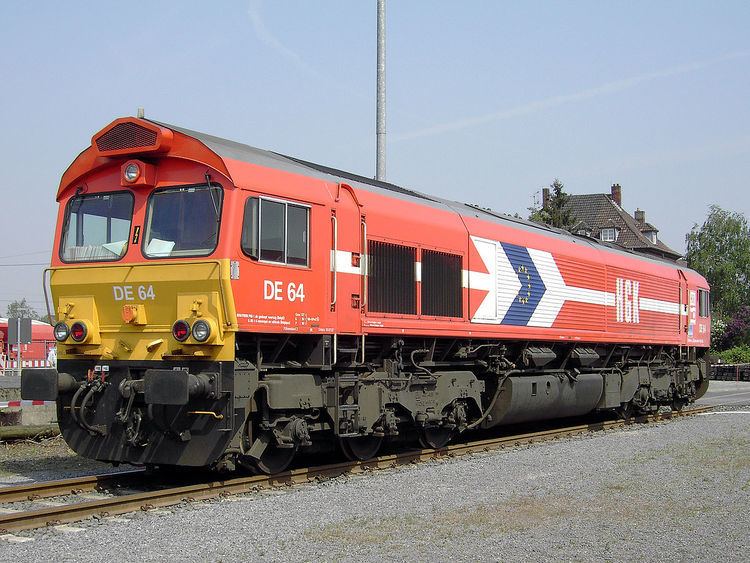Model EMD JT42CWRM Total produced 651+(7) | Build date 1998 to date UIC class Co'Co' | |
 | ||
The Electro-Motive Diesel (EMD) Class 66 (or JT42CWR) are Co-Co diesel locomotives built by EMD for the European heavy freight market. Designed for use in Great Britain as the Class 66, a development of the Class 59, they have been adapted and certified for use in other European countries. Outside Europe, 40 locomotives have been sold to Egyptian Railways for passenger operation.
Contents
- United Kingdom
- Mainland Europe
- Class 77
- Class 66EU
- Technical
- ETCS Equipment
- Idle reduction
- Europe
- Middle East
- References
A number of locomotives built for Euro Cargo Rail in France with roof-mounted air conditioning are classed Class 77. In Germany ECR units operated for DB Schenker were numbered as class 247, re-classified as class 266 by the Eisenbahn-Bundesamt to match other Class 66 locomotives operating in Germany.
United Kingdom
The class was designed by General Motors-Electro Motive Division for use in the UK, and 250 were sold to English Welsh & Scottish, with orders from Direct Rail Services, Fastline, Freightliner and GB Railfreight.
Mainland Europe
With the locomotives proving successful in the UK, interest came from railway operators in Europe. General Motors locomotives in mainland Europe had historically been produced under license by local manufacturers. The high haulage capacity and reliability of the Class 59 (JT26-CW-SS) had led to its use by the German company Häfen und Güterverkehr Köln (HGK). The first mainland Europe order also came from HGK, for two locomotives, followed by TGOJ Trafik (Trafikaktiebolaget Grängesberg-Oxelösunds Järnvägar) in Sweden. Subsequently many European railway operators bought locomotives.
Class 77
With a high number of orders, EMD modified the locomotive for European ECR operations, including:
Designated JT42CWRM-100 by EMD and registered in France as Class 77, over 100 locomotives have been purchased including 60 by DB Schenker subsidiary Euro Cargo Rail.
Class 66EU
In 2008 EMD announced plans to develop a new variant 'Class 66EU' designed for continental European operations, built within the UIC 505-1 loading gauge as opposed to the restrictive UK loading gauge. A range of European safety systems would be supported including ERTMS, and locomotives would be fitted with a dynamic brake and previous issues with driver comfort were to be addressed. The project was confirmed to be cancelled in 2011.
Technical
The locomotive uses standard EMD components - an EMD 710 prime mover, D43 traction motors, radial (self-steering) bogies of patented design, which reduce wheel surface and flange wear and is said to improve adhesion and reduce track load.
The class has undergone updates; other than the lower-geared class 66/6 produced for Freightliner, most of the updates have been in relation to conforming to specifications for exhaust particulate emissions.
Despite being popular with rail operators, especially due to its high reliability, the class has not been universally successful: one recurring problem has been driver comfort. In particular, noise levels (including noise from the cab horn), vibration, and excessive cab-temperatures in hot weather have brought serious complaints. The cab is not isolated from the main frame, causing engine noise to be the dominant background noise; notwithstanding the implications for safety (audibility of warning signals etc.), and the potential for hearing damage in the long term, the conditions drivers face led to threats of industrial action in the UK in 2007, and an agreement for increased pay for drivers using this type of locomotive (in Norway). By modifying using noise absorbing materials EMD succeeded in meeting TSI Noise Certification standards in 2008. Tests on retrofitted cooling systems and improved seating have been carried out on some UK locomotives.
ETCS Equipment
Between 2006 and 2010, 12 locomotives belonging to Mitsui Capital Rail Europe (MRCE), operating in the Netherlands and Germany, were equipped with ETCS, principally to allow them to work on the equipped Betuweroute, comprising the ETCS Level 1 "Havenspoorlijn" in the Rotterdam harbour area and the ETCS Level 2 "A15" route linking Rotterdam to the German border.. The MRCE locomotives were sold to Beacon Rail in 2015. Commencing in 2015, 15 locomotives owned by Ascendos Rail Leasing and 10 locomotives owned and operated by Crossrail Benelux were equipped with ETCS.
Idle reduction
As a fuel-saving and wear-reduction measure operator DB Schenker Rail UK is to fit ninety of its fleet with automatic engine stop start technology by the end of 2015. The modification is provided by ZTR Control Systems of London, Ontario and is expected to reduce engine running hours by about one-third.
Europe
Certification (homologation) is needed for each country of operation. The locos were initially given a temporary certificate for use in France, and full certification came in 2009 (they had previously operated in France on some routes), Romanian certification came in 2007 The class is certified for operation in Germany, the Netherlands, Luxembourg, Belgium, Sweden, Norway, Poland and Denmark. As of 1 January 2009, certification for use in the Czech Republic and Slovakia was pending.
Middle East
They are operated in Egypt by the Egyptian National Railways.
